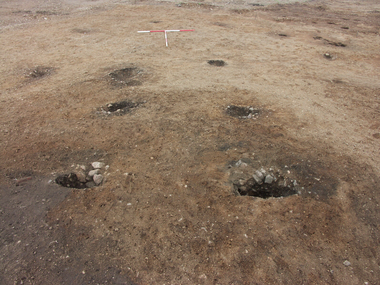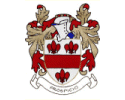Cheviot Quarry, Northumberland: Excavation and Interpretation
Archaeological Research Services Ltd, 2008. https://doi.org/10.5284/1000251. How to cite using this DOI
Data copyright © Archaeological Research Services Ltd unless otherwise stated
This work is licensed under the ADS Terms of Use and Access.
Primary contact
Archaeological Research Services Ltd
Angel House
Portland Square
Bakewell
DE45 1HB
UK
Tel: 01629 814540
Resource identifiers
- ADS Collection: 779
- ALSF Project Number: 4642
- DOI:https://doi.org/10.5284/1000251
- How to cite using this DOI
Overview

Archaeological excavations in advance of quarrying at Cheviot Quarry have produced evidence for Neolithic, Late Bronze Age and Dark Age settlement. Neolithic pit features containing domestic midden material including broken pottery, lithics and cereal grains, have provided evidence for what is thought to be settlement and subsistence activity from the Early through to the Late Neolithic period. Together with the Neolithic remains from the nearby site at Thirlings, these two areas of settlement provide an important accompaniment to the better known ceremonial complex located nearby.
Radiocarbon determinations associated with the full range of Neolithic pottery found in Northumberland have been obtained and analysis of the residues adhesing to the ceramics has provided some of the earliest evidence for dairy farming, as well as information relating to other dietary and subsistence practices. Two substantial roundhouses with protruding porches, internal hearths and pits containing domestic refuse, provide the first evidence for Late Bronze Age lowland settlement in the region. The botanical macrofossil evidence, together with the pottery residues, show clear evidence for arable and pastoral agriculture in a small, unenclosed farming settlement. A detailed programme of radiocarbon dating and the application of Bayesian modelling has shown that these two buildings are contemporary and date to the tenth century cal BC. In addition to this prehistoric archaeology three Dark Age rectangular post-built buildings were also discovered on the site and have been radiocarbon dated to the fifth or early sixth centuries cal AD.
These substantial structures are thought to represent the homesteads of a small farming community, although the lack of material culture from these heavily truncated structures makes understanding their cultural attribution problematic. Because of their early date these buildings could have belonged to either post-Roman British inhabitants or perhaps early Anglo-Saxon settlers. A reconstruction of one of these buildings has been built close to the site at the nearby Maelmin Heritage Trail where it can be visited by the public. The area of Cheviot Quarry also encompasses the former site of RAF Milfield, a World War II training airfield, which played a significant role in the success of the Allied advance into Europe.
The digital archive
The project dataset contains the primary site excavation archive as well as a series of reports:
Project Reports
The stratigraphic report, complete with figures and appendices can be accessed from the downloads page. When quoting this work please use the following reference:
- Johnson,B. and Waddington,C. 2007: Excavation at Cheviot Quarry, Northumberland, 2005. ARS Ltd Report No. 2006/2. January 2006
In addition the archive also includes the full array of post-excavation specialist reports comprising:
- Geochemical - 1 text document of results of geochemical analysis
- Botanical macrofossils - 3 text documents containing results of assessment and analysis of botanical macrofossils recovered from the site
- Residue - 1 text document containing results of analysis of residues adhering to ceramics recovered from the site
- Worked Stone - 2 text documents, one on analysis of coarse stone artefacts and one on analysis of lithic material recovered from the site
- Ceramic - 1 text document on analysis of ceramic material recovered from the site
- Dating - 1 text document including illustrations
- Assessments - a further 6 reports comprising:
- Bone - 1 text document
- Ceramic - 2 text documents, one on ceramics and one on ceramic residues
- Charred Material - 1 text document
- Coarse Stone - 1 text document
- Geochem - 1 text document
- Lithics - 1 text document
Primary Site Archive
Site Survey: A Drawing Interchange File (DXF) of all surveyed data from site. Within the DXF file the following conventions are used:
| Layer | Convention | Comment |
|---|---|---|
| Lines | Polyline | Edge of excavation areas; locartion of sections |
| P03_SAMPLE_LOCS | Points | Location of samples |
| P03_SAMPLE_TEXT | Text | Sample ID |
| SURVEY_POINTS | Points | Original survey points |
| TEXT | Text | Text (feature number etc) |
Site photographs: Over 400 digital photographs in jpg (raster) format, can be downloaded here
Site matrices: Matrices of Early and Late Neolithic stratigraphic units.
Site Registers: 11 PDF documents comprising all the digitised site recording sheets:
- Black and White photograph register - list of all black and white photographs taken
- Colour photograph register - list of all colour photographs taken
- Digital photograph register - list of all digital photographs taken
- Context register - table of all contexts with brief descriptions of each
- Context Register Assoc - table of all contexts with information regarding small finds and environmental samples associated
- Dating Sample Register - list of all samples taken for radiocarbon dating
- Drawing Register - list of all site plan and section drawings
- Environmental Sample Register - list of all environmental samples taken
- Finds Register - list of all finds recovered
- Levels - list of all reduced levels
- Slide register - list of all slide photographs taken
Non-digital Archive and Publications
In addition to the reports and data contained within the digital archive the project also produced the following outputs:
| Literary Outputs |
|---|
| Johnson,B. and Waddington,C. (in prep), A prehistoric and early medieval settlement site in the Milfield plain, Northumberland. Archaeological Journal. |
| lectures / Academic Papers |
| Lecture by Dr Clive Waddington at Land and People : Conference in honour of John G. Evans. 25/03/2006 |
| Lecture by Dr Clive Waddington to Society of Antiquaries of Newcastle upon Tyne. 26/04/2006 |
| Lecture by Dr Clive Waddington to the European Association of Archaeologists at Krakow, Poland. 22/09/2006 |
| Five public talks to local interest groups : Howick History Society, PROBUS, Borders Archaeological Society, Alwick History Society, Northumberland Archaeological Group. |
| Educational Visits |
| The project received 30 visits from Northumberland school groups. |
| Guided Tours |
| Over 20 guided tours around the Maelmin Heritage Trail. |
| 15 guided tours around the surrounding landscape. |
| Press Release |
| News release prepared in conjunction with Tarmac Ltd, Northumberland County Council, English Heritage and ARS Ltd |
| Radio / TV interview |
| Radio 5 Live, Radio Borders, Radio Newcastle, BBC National News, ITV Local News (Calendar) |
| CBA National Archaeology Events |
| National Archaeology Week 24th - 25th July 2006: attended by all ages. |
| Other |
| Seven visits to Old Age People's homes and giving talks, pottery handling and talks about wartime memories. |
| Presence at community events e.g. Berwick Green Festival, Berwick Youth Festival. |
| Address to Berwick Borough Local Strategic Patnership (Berwick District Council). |
| Reconstruction of a Dark Age building with local volunteers and professional craftsmen. |
The Archaeology Data Service (ADS) do not hold any further information regarding these non-digital outputs, any queries should be directed to the depositor.







